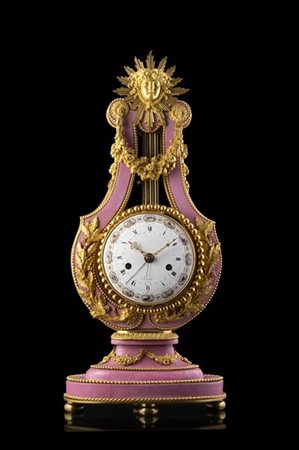 Il Ponte Casa d'Aste - Palazzo Crivelli - Via Pontaccio 12, 20121 Milano
Il Ponte Casa d'Aste - Palazzo Crivelli - Via Pontaccio 12, 20121 Milano
ASTA 547: VALENTINA CORTESE II TORNATA : dal lotto 110 al lotto 301
mercoledì 2 marzo 2022 ore 15:00 (UTC +01:00)
KINABLE A PARIS Importante Pendola a "lira" con cassa in porcellana di Sčvres
KINABLE A PARIS
Importante Pendola a "lira" con cassa in porcellana di Sčvres rosa e bronzi dorati. Quadrante firmato da Duboisson in smalto con ore, minuti, mesi, segni zodiacali e giorni del mese. Movimento a due treni con scappamento a caviglie e suoneria delle ore e mezze su campanello. Francia, 1785/1790 (cm 59x28) (difetti)
Si tratta di una tipologia di grande importanza di cui sopravvivono vari esemplari sia con finitura in porcellana rosa sia blu. Due modelli quasi uguali (di cui uno acquistato nel 1828 da Re Giorgio IV) si trovano nella British Royal Collection. Un terzo precedentemente conservato a Versailles, ora si trova al Louvre. Ed infine un quarto al Victoria and Albert Museum.
Dieudonnč Kinable č stato un orologiaio molto noto per questo tipo di orologi, cosě come anche per quelli a "scheletro". Č noto che acquistasse le componenti delle casse presso le manifatture di Sčvres per poi servirsi dei migliori smaltatori dell’epoca per la decorazione dei quadranti. I due smaltatori piů noti di quel tempo erano Joseph Coteau (1740-1801) e Etienne Gobin, anche conosciuto come Duboisson (1731-dopo il 1815).
Bibliografia:
Pierre Kjellberg, "Encyclopédie de la Pendule Française du Moyen Age au XXe Sičcle", 1997, p. 230;
Tardy, "La pendule Française. Des origines ŕ nos jours 2me partie", 1969, pp. 281-282
-EN
A 1785-90 French ormolu-mounted Sčvres pink porcelain lyre clock, the dial signed Kinable a Paris and Dubuisson. The circular dial decorated with oval enamelled placques depicting the twelve zodiac signs and inscribed with the names of months and days. Two-trains movement striking the hours and half (cm 59x28) (defects)
NOTES
Different exemplars of this very important model survive both in blue and pink finish. Two almost identical exemplars (one bought in 1828 from King George IV) are placed in the British Royal Collection; another one, formerly housed in Versailles, is now at the Louvre. Another one is at the Victoria and Albert Museum.
The clockmaker Dieudonné kinable was very well-known for this kind of clocks and for the "skeleton" clocks. It is known that he acquired the case components in Sčvres and he employed the best enamellers of the time to decorate the clock dials. The most important enamellers of that time were Joseph Coteau (1740-1801) and Etienne Gobin, also known as Duboisson (1731-after 1815).
Bibliography:
Pierre Kjellberg, 'Encyclopédie de la Pendule Française du Moyen Age au XXe Sičcle'97, p. 230.
Tardy, La pendule Française. Des origines a nos jours 2me Partie. 1969, p. 281-282






